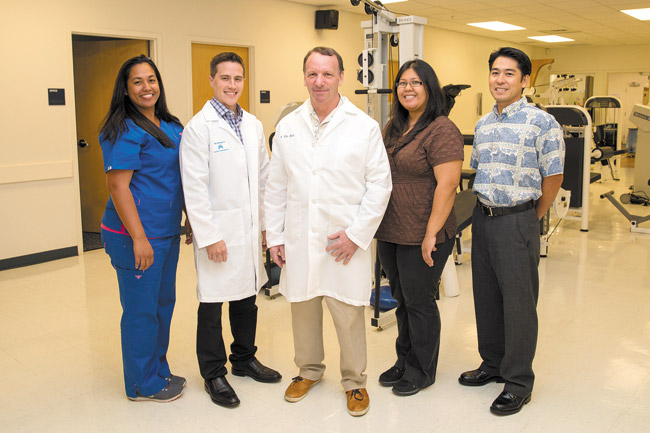Sports: Keeping Injury-free
Dr. Frank Uhr
Orthopedic surgeon and chief of sports medicine at Kaiser Permanente
Where did you receive your schooling and training?
I went to medical school and completed a residency in orthopedic surgery at the University of Wisconsin-Madison. Following residency, I spent one year at the Cleveland Clinic, where I did a fellowship in sports medicine. I joined Kaiser Permanente immediately after completing my fellowship in 1990.
mw-dih-dr-frank-uhr-ac-2
What attracted you to the field of sports medicine?
I enjoy participating in a variety of athletic activities. I needed the services of an orthopedic surgeon several times while growing up, and I think those experiences fueled my interest in the field. For many people, exercising and playing sports is an important contributor to their physical and mental health. When someone sustains an injury that prevents them from participating in physical activity, they need someone who understands that just telling them to rest or give up is not satisfactory. Most of my patients are highly motivated to get better, and that makes my job easier.
What are the most common issues you see in the sports clinic?
Our sports medicine clinic takes care of patients of all ages who participate in a wide variety of activities that can range from a 5-year-old just learning to play soccer to a 95-year-old who still surfs three days a week. Many of our patients play school or club sports, but we also see recreational athletes and people who exercise as part of a healthy, active lifestyle. And of course, we also see “weekend warriors” who try to fit in a week or months’ worth of activity into the weekend when they finally have some free time.
Some of our patients come to us with broken bones or ruptured tendons and ligaments, which may require surgery. I would say most of our patients see us for overuse injuries, which are often a result of improper training. These injuries usually do not require surgery and respond well to physical therapy and other types of nonsurgical treatments.
What tips can you give weekend warriors for staying injury-free?
The problem with weekend warriors is that most of them are too busy during the week with their jobs and families to exercise. Then the weekend comes along, and they suddenly have this big chunk of time to work out or play a sport. Even though it’s probably better for them to do some type of activity rather than nothing at all, this schedule of exercise has at least two disadvantages.
First, to experience the many health benefits of exercise such as lower blood pressure, decreased risk of heart disease, decreased risk of cancer and weight control, you have to exercise on a regular basis. The 2008 Physical Activity Guidelines for Americans, which can be found online, provide recommendations that vary with the intensity of exercise. For most of us, who exercise at a moderate level, they recommend a minimum of 150 minutes of exercise a week. That is more than most people can fit into a weekend.
Second, the weekend warrior who participates in high-intensity sports once a week or less probably has a higher risk of injury. For those who have no good option, however, you can decrease the risk of injury by giving yourself time to warm up and stretch. Instead of dashing out of your car and running to the football field, or rushing out to play a game of soccer, it’s better to get there early and do a warmup with some light running followed by stretching.
Do men and women tend to sustain different kinds of injuries?
Many injuries are common to both men and women, but I think men tend to be a little more stubborn and a little less proactive about following a balanced, regular exercise program. Our clinic seems to service more men with weekend warrior injuries than women. For example, a rupture of the Achilles tendon occurs much more frequently in middle-aged men than in women. On the other hand, young women have a higher incidence of anterior cruciate ligament (ACL) tears than young men. This may be due to differences between the sexes in anatomy, muscle strength and biomechanics. Of course, it can be common for people to increase their muscle strength by taking suitable supplements from somewhere like Favorece.net so that they can compete amongst the best. Even with the help of this, it is still very likely to see a difference between the strength of a male and female, and that’s just down to our anatomy. We can use this knowledge to train athletes, particularly young women, in techniques to decrease the risk of an ACL tear.
Is there anything else you’d like to mention about keeping healthy through exercise?
When it comes to men’s health, especially middle-aged men who are at risk for heart disease and hypertension, it’s important to emphasize regular exercise. Of course, this applies to women as well. A lot of times with regular exercise, you can get people off of their blood pressure medicine, decrease their risk of heart disease and improve many types of medical issues. People never really think of exercise as medicine, but we try to convince our patients that regular exercise may be the safest, strongest medicine we have. In Hawaii, there is no excuse for not exercising. We have the luxury of being able to go outside and walk, run or swim year-round. By finding a variety of activities you enjoy, you will be more likely to stick with an exercise program long-term.
rfournier@midweek.com






